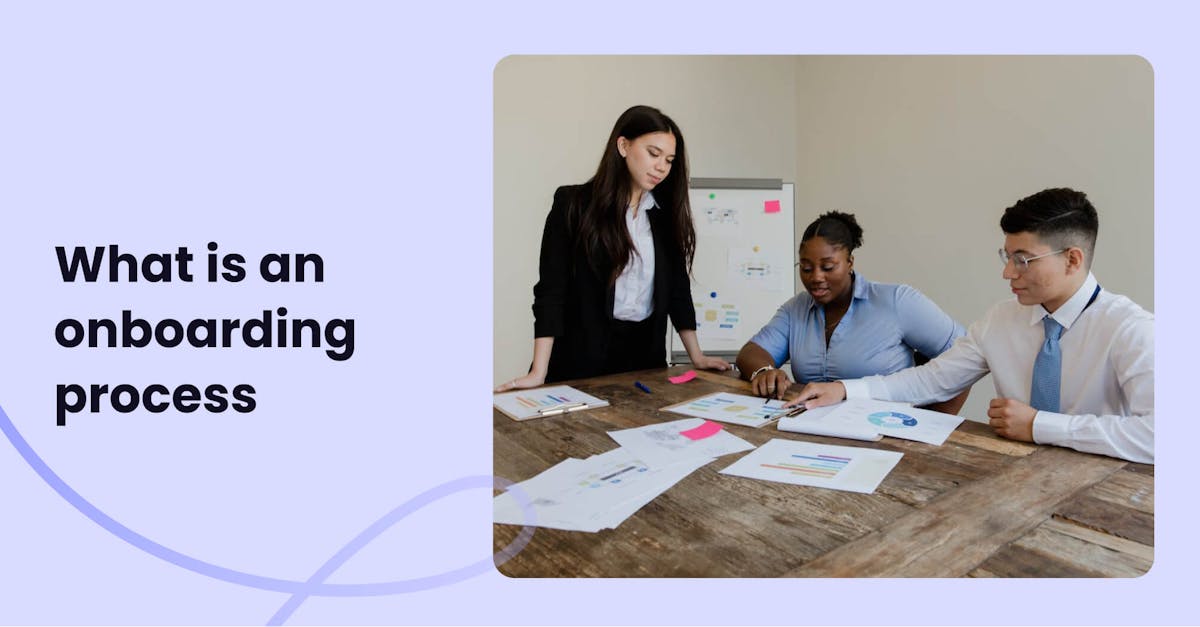What is onboarding process: a comprehensive guide to welcoming new hires

Onboarding new hires is a crucial step for any company looking to build a strong, long-lasting team. But where do you begin? In this article, we'll take you through the ins and outs of the onboarding process. We'll show you why it's so important and guide you on how to do it right. Plus, we'll share our top picks for tools to help you streamline your onboarding process.
What is onboarding and why it matters
Onboarding is the process of welcoming new employees into your organization. But, the onboarding process meaning goes beyond just showing them where the coffee machine is or handing them a handbook. It's about guiding them in every aspect of their job so they feel like they belong and are valued. Here, they can gain a deeper understanding of their job responsibilities, their coworkers, as well as the company's overall values and mission.

So why does onboarding matter? It’s because this program sets the stage for long-term success. A strong onboarding process helps new hires feel welcome, confident, and prepared to tackle their new role. It can also increase employee engagement, retention, and productivity.
When done right, onboarding can build a strong and cohesive team that's aligned with your company values and goals.
Level up your onboarding program with the best onboarding tool today! EdApp’s key onboarding features include creation tool, gamification, practical assessment, analytics suite, and more.
The benefits of a strong onboarding program
Onboarding for a job is much more than just a task checklist. It also helps new hires to settle into their position more quickly and that they feel like they’re a part of the team from the minute they join. Here are some more benefits of investing in a strong onboarding program:

- Increased employee retention: When employees feel valued and supported during the onboarding process, they're more likely to stay with the company long-term.
- Improved employee engagement: A strong onboarding program can help employees understand how their role fits into the bigger picture, leading to greater job engagement and satisfaction.
- Higher productivity levels: By giving your new employees the tools and resources they need to succeed, they can begin contributing to the company more quickly.
- Enhanced company culture: Onboarding is that perfect opportunity to showcase your company's culture and values. This helps your new hires feel more connected to the company and its mission, resulting in a more positive and productive workplace.
A step-by-step guide to onboarding process
The onboarding process is the key to a successful start for your new employees. It sets the tone for their entire experience with your company and helps them feel welcomed, supported, and excited about their new role. Guide your new hires through a friendly and effective onboarding process by following these steps below:

Step 1: Send pre-onboarding email or letter
Before your new hire starts, it's essential to reach out and show them that you're excited to have them onboard. You can do this by sending them onboarding kits, a friendly welcome email, or a letter that covers all the important details, like their start date, the time of their first day, and who they'll be working with.
Don't forget to include any paperwork they need to fill out, so they can get a head start and feel prepared before they start their first day with your company.
Step 2: Prepare an orientation
It's also important to prepare engaging orientations with activities and introductions to help your new hires feel like they're part of the team. Start with an onboarding meeting, follow up with an office tour, and then introduce them to their team members, key stakeholders, and managers. You can also take advantage of this activity to orient them with your company’s mission, values, and culture.
Step 3: Set goals and expectations
Setting clear expectations and goals will allow your new team members to better understand what's expected of them, giving them a sense of purpose and direction as they move forward.
For this onboarding process, make sure that your goals are specific and detailed. Outline what their responsibilities will be, what tasks they'll be expected to perform, and how their work will contribute to the company's overall success.
Step 4: Train your new hires
Help your new employees hit the ground running by organizing training sessions that’ll introduce them to the tools, processes, and regulations or laws that are relevant to their role. There are two ways you can approach your training programs: the traditional way, where you hold everything in person, or the digital approach, which can save you time and money.
With online training, you can work with training platforms like EdApp to create elearning courses that your employees can take anytime and anywhere. EdApp’s Briefcase feature stores training manuals and other important resources that your team can always refer back to as needed.
Step 5: Schedule regular check-in
Regular check-ins are an important part of the onboarding process. They can be used to give feedback and support to your new employees, as well as measure their progress to make sure that they're on track of their goals. Scheduling these check-ins also creates a space for open communication and collaboration. Here, you can follow up with them, see if they feel comfortable in their role, and address any remaining questions or concerns about their role or the organization in general.
Best practices to make your onboarding process more effective
For a foolproof onboarding program, here are some onboarding practices that you can follow to make the process smooth and effective.

- Create a comprehensive onboarding plan. It should include a series of orientation activities, training on company tools and processes, goal setting, and regular check-ins. You can also use it as a checklist to make sure you’re not missing any important onboarding process.
- Assign a mentor or buddy. Pair your new hires with senior employees to help them easily adjust to their role. Make sure that they can answer questions and can effectively guide the hires during their first few weeks on the job.
- Collect feedback from new hires. After every onboarding, get your new hires’ feedback on the areas where they may be struggling. Use this opportunity to develop a plan on how they can improve and better achieve their goals.
- Continuously evaluate and refine your onboarding program. As your company grows and changes, your onboarding process should also evolve to reflect any new policies, technologies, or procedures.
Updating your onboarding process can also help address any areas of weakness and improve the overall experience for new hires, leading to increased engagement, retention, and productivity.
Why EdApp is the go-to onboarding tool for today's businesses
When it comes to onboarding new hires, having a reliable and easy-to-use tool is crucial. That's where EdApp comes in as the best onboarding tool today.

With this onboarding LMS, you can create onboarding training materials like microlearning onboarding courses, training manuals, and quizzes in no time. Plus, your new hires will get access to a library of 1000+ ready-made courses from industry leaders like AXA Climate and Thai cave rescue diver John Volanthen.
If you can’t find an onboarding course that works for them, then EdApp’s course creation service is the ultimate lifesaver. Here, you can work with their expert team of instructional designers to build professional-looking courses.

EdApp is also equipped with the latest learning strategies, such as microlearning, gamification, and spaced repetition, so you can rest assured that your training will have a lasting impact on your employees.
EdApp is the best onboarding tool in the market. Try its features today!
Author
Jen Avelino
Jen is a learning expert at EdApp, a mobile-based training platform that helps corporates and businesses bring their training solutions to the next level. She carries an extensive writing experience in a variety of fields, including architecture, the gig economy, and computer software. Outside of work, she enjoys her free time watching her favorite series and documentaries, reading motivational books, and cross-stitching.
